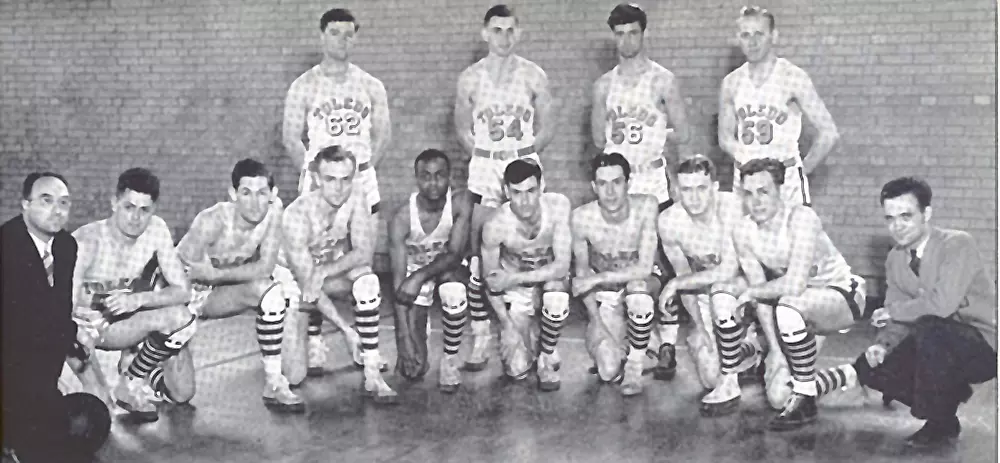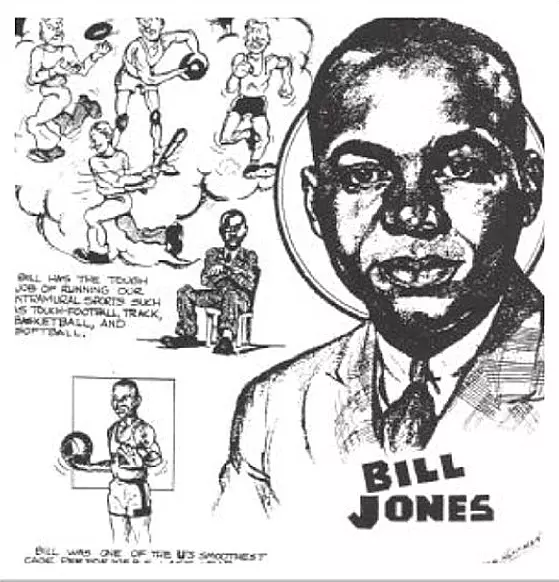Basketball
Although Toledo had professional basketball for less than a decade, the area still was able to make its mark on the integration of the game.
Toledo Professional Basketball
James Naismith, the creator of modern basketball, brought the game to Toledo at the turn of the twentieth century. Naismith, who invented the game at the Springfield, MA YMCA as a bridge sport between football and baseball seasons, introduced Carl Meissner and Howard Green to the game while they were working at the Toledo YMCA. Green and Meissner quickly introduced the members of the local YMCA to the sport and the game began to grown in Toledo.
African Americans were able to play basketball in Toledo in the high school system. It was through this system that the players that made up one of the earliest Toledo basketball franchises, the Ciralsky Packers (teams were commonly named after the sponsors), came into being. The team would play against white teams in the city, as well as barnstorm across the United States. Led by players such as Bill Jones (first black professional basketball player), Link Smith (player and coach), Randolph Smith, and Herb "Shine" Taylor, they played white and black teams alike. The team was so successful they even defeated the professional New York Celtics, 30-27, in 1934.
Since the YMCA, like most American institutions, was segregated, an all-black YMCA was built in 1931. This new institution, like the segregated YMCA did for the white community, helped grow the game in Toledo’s African American community. The game would continue to grow at the University of Toledo as well, under the tutelage of Harold "Andy" Anderson.
In the 1940s, Toledo fielded its first professional team, the Jim White Chevrolets. The team suffered through a painful first season, finishing with a 3-21 record. 1941-1942 resulted in the drafting of many of the team’s players for military service – including star Chuck Chuckovits – and the team quickly turned to African American players from the area. Along with the Chicago Studebakers, the Toledo franchise was one of the first to integrate. Players such as Bill Jones, Casey Jones, Al Price, and Shannie Barnett all played for the Toledo club during this second season.
The war, coupled with the lack of popularity of the sport, led to the demise of the team after the 1942-1943 season. Although a few other teams were created, professional basketball in Toledo would never muster enough support to survive.
William Jones
 William Jones and his teammates, 1938
William Jones and his teammates, 1938
William Jones was one of the first great basketball players from Toledo. Jones led his Woodward high school basketball team to back- to-back Toledo city championships in 1928-1929 and 1929-1930, as well as leading his local YMCA team to various championships and undefeated seasons. Jones would continue his career at the University of Toledo, leading the team in scoring during the 1933-1934 season and starring with All-American Chuck Chuckovits on the 1936-1937 and 1937-1938 University of Toledo basketball teams, both of which finished ranked in the National Top 20.
Jones would continue to play basketball, this time with various barnstorming teams such as the Toledo White Huts (after the hamburger franchise), Joe's Toledoans, Ciralsky Packers, and the Harlem Globetrotters. In the 1942-1943 season, Jones, along with three other teammates and six players from the Chicago Studebakers of the NBL, officially integrated the sport (in 1950, Earl Lloyd became the first black NBA player). This occasion was not as momentous as Jackie Robinson four seasons later due to the lack of popularity of the new sport, coupled with the ever-increasing role of the United States in World War II.
Jones would play just one season with the Jim White Chevrolets of the NBL, with the team compiling a losing record that season and quickly disbanding the following season when Chuck Chuckovits did not return from the war.
Jones would continue to be a pioneer after his short basketball career ended. After relocating to the Los Angeles area, Jones, through the Los Angeles Urban League, was able to help secure employment for the first minority in 1946. Jones would continue to be associated with basketball, playing and owning various traveling teams, refereeing local Los Angeles games, and giving free coaching clinics throughout his life.
In 1991, Jones was inducted into the University of Toledo Athletic Hall of Fame for his exploits on the hardwood for the Rockets. He would live out the remaining years of his life in Los Angeles, passing away on May 7, 2006.

